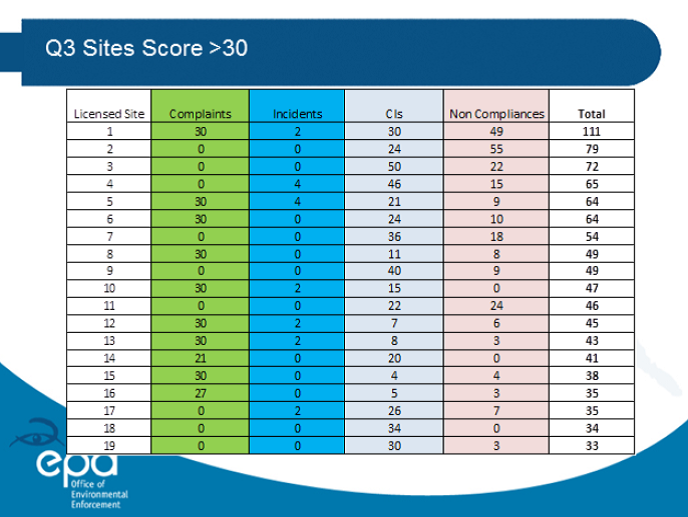2016 EPA Enforcement Priority Site List – How can Licensees stay off the EPA’s “Naughty List”?

In late 2015, the Environmental Protection Agency's (EPA) Office of Environmental Enforcement announced the roll out of a "National Priority Site List". For a number of years the EPA has, internally, been using various risk ranking tools (RBME etc.) and prioritised listings as a means of ensuring that the EPA licensed sites with the poorest environmental track records (highest numbers of non-compliances, incidents, complaints etc.) are allocated a suitably greater proportion of the EPA's available enforcement resources. This ensures those sites are enforced back to compliance within the shortest timeframe possible, while at the same time most compliant sites could expect to receive lesser numbers of inspections and enforcement.
The significant change announced in late 2015 was that a systematic points based prioritisation system has now been introduced and the EPA intends to make scoring information publicly available in the coming months. That information will be in the form of a league table which will be updated on a quarterly basis – licensees will move up or down the list depending on how quickly and effectively they deal with their current compliance investigations, incidents and complaints.

Whilst the use of similar "League Tables" has been employed by equivalent Environmental Protection Agencies around the world, the need for the revised approach in Ireland is unclear. Serial offenders in Ireland have generally been firmly dealt with by the EPA and the Irish legal system (though the levels of fines imposed for offenses in many cases remains low). Many of Ireland's industrial licensees are owned by multinational corporations, many of whom will have had little or no bad publicity in Ireland to date. It remains to be seen how these companies will view these changes, if their facility does indeed feature on the Priority List.
AWN has put together initial guidance below to assist licensees in finding their feet with the new system. We hope these suggestions will assist licensees not on the Priority List to stay off the List while helping licensees that are on the list to get their facility off the list as quickly as possible!
For clarity, the Agency have set the bar for featuring on the list at >30 points. At between 20 and 30 points the Agency will advise the licensee of their position. At the end of Q3 2015, there were only 19 sites on the list, however, it is understood that this number has increased during Q4 2015. At the time of writing, it is unclear when the system will go public.
1. Prioritise dealing with Compliance Investigations – Depending on the seriousness of the compliance investigations (C.I.s) on a licensee's file, the EPA may allocate up to 20 points for each C.I. (up to a maximum of 3 C.I.s). C.I.s that are still open score higher points than ones that have been closed, so under the EPA's site scoring system open C.I.s will very often represent a significant proportion of the overall site score. As such all C.I.s should be closed out as swiftly as possible to ensure they score the minimum number of points.
2. Confirm your score for each new C.I. – Importantly all licensees should ask their Inspector what category has been assigned to a new C.I. when received so that they may be fully aware of the potential implications from the outset i.e. will it result in a priority listing? Previously the licensee would not generally have been told what severity has been applied to a C.I. – it is understood the EPA are working on making this process more transparent. This may present a significant difficulty for the system if this issue is not resolved in the short term.
3. Confirm the severity of each environmental incident and ensure it is appropriate – Incidents that are categorised in accordance with the EPA incident reporting methodology as minor incidents incur 0 points. However it is apparent from discussions with licensees that there can very often be uncertainty/subjectivity around whether an incident is categorised in the limited or minor category. Serious, Very Serious and Catastrophic incidents will incur between 10 and 30 points, however, very serious and catastrophic incidents rarely occur. It is now considered essential that licensees confirm the actual impact of their incidents (by carrying out the necessary assessment, modelling and reporting to the EPA) to ensure each incident is appropriately scored.
4. Tackle complaints head on – From the information made available by the EPA to date, the profile of the licensees on the current Priority List seems to vary widely. Several facilities appear to have been placed on the list primarily because of multiple long running C.I.s, some seem to appear because of large numbers of complaints (certain sections of the waste industry have historically tended to receive large numbers of complaints so this is not altogether surprising). AWN suggests that investigating, engaging and addressing the concerns of complainants is now ever more critical (especially those tied to C.I.s). Though the EPA has set a cap of 30 points for complaints, regular complaints can quickly result in a site reaching the 30 points necessary to enter the List or in the worst case cause a facility already in trouble to move up towards the top of the List (due to a spiral of complaints from the recent incident or C.I. that has required the EPA's intervention).
5. Getting off the list is not as quick as getting on – Licensees on the List will move up and down the List on a quarterly basis. However, it should be noted that it is the score for the previous 12 months that is used to calculate Priority List position – therefore at worst there may be a time of several months before a licensee comes off the list. The only way licensees can minimise the time spent on the List is by carrying out the various actions above – greatest of all being the need to reduce the scores of the C.I. or incident resulting in a listing in the first place.
For more information contact:
David Mc Dermott (Associate Director) david.mcdermott@awnconsulting.com
Dr. Fergal Callaghan (Director) fergal.callaghan@awnconsulting.com